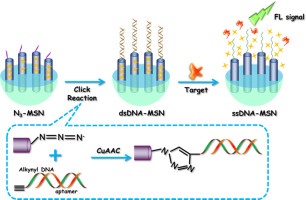Talanta ( IF 6.1 ) Pub Date : 2017-09-19 , DOI: 10.1016/j.talanta.2017.09.043 Zhonghui Chen , Mi Sun , Fang Luo , Kefeng Xu , Zhenyu Lin , Lan Zhang

|
In most aptamer based stimulus response mesoporous silica nanoparticles (MSN) systems, the aptamer is modified on the MSN via electrostatic interaction, however leakage might exist after a certain time in the system and hence the stability is not good. In this study, the pores of MSN were capped by aptamer through click chemistry reaction for the first time and the system was then employed to develop a fluorescence biosensor. Specifically, the aptamer of the target (thrombin in this study) was hybridized with its complementary DNA (which was initially modified with alkyne at the terminal) to form a double strand DNA (dsDNA) firstly, and then this dsDNA was modified on N3 modified MSN via Cu(I) catalyzed alkyne-azide cycloaddition reaction. The guest molecules (fluorescein) were blocked in the pores of the MSN with high efficiency and nearly no leakage was detected. Upon the introduction of thrombin, thrombin specifically recognized its aptamer, so aptamer released from the MSN; and the single strand DNA(ssDNA) left could not cap the pores of the MSN efficiently and hence caused the releasing of fluorescein into the solution. The enhanced fluorescence intensity of the system has a good linear relationship with the thrombin concentration in the range of 50–1000 ng mL−1 with a detection limit of 28.46 ng mL−1. The proposed biosensor has been successfully applied to detect thrombin in serum samples with high selectivity. The same strategy can be applied to develop biosensors for different targets by changing the adopted aptamer.
中文翻译:

基于刺激响应点击化学的适体功能化介孔二氧化硅纳米颗粒,用于凝血酶的荧光检测
在大多数基于适体的刺激响应介孔二氧化硅纳米颗粒(MSN)系统中,适体是通过静电相互作用在MSN上修饰的,但是在系统中经过一定时间后可能会出现渗漏,因此稳定性不好。在这项研究中,MSN的孔第一次通过点击化学反应被适配子覆盖,然后被用于开发荧光生物传感器。具体而言,将靶标的适体(本研究中的凝血酶)与其互补DNA(最初在末端用炔烃修饰)杂交,形成双链DNA(dsDNA),然后在N 3上修饰该dsDNA。通过Cu(I)催化的炔-叠氮化物环加成反应改性MSN。客体分子(荧光素)被高效地封堵在MSN的孔中,几乎未检测到泄漏。引入凝血酶后,凝血酶会特异性识别其适体,因此适体会从MSN中释放出来。并且留下的单链DNA(ssDNA)无法有效覆盖MSN的孔,从而导致荧光素释放到溶液中。系统增强的荧光强度与凝血酶浓度在50–1000 ng mL -1范围内具有良好的线性关系,检出限为28.46 ng mL -1。所提出的生物传感器已成功应用于高选择性检测血清样品中的凝血酶。通过更改采用的适体,可以将相同的策略应用于针对不同目标开发生物传感器。



























 京公网安备 11010802027423号
京公网安备 11010802027423号